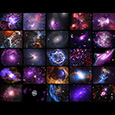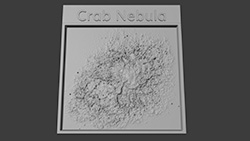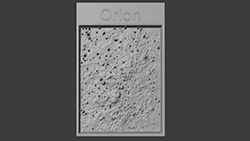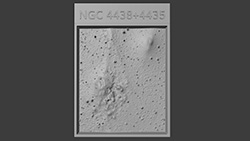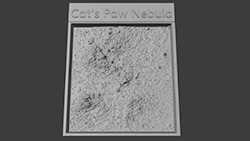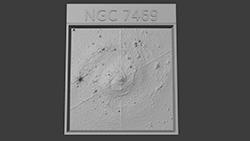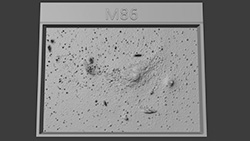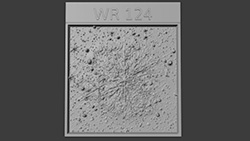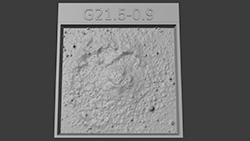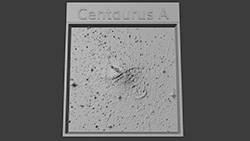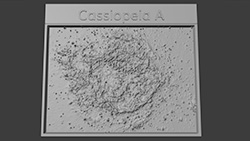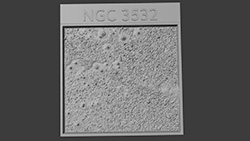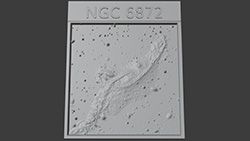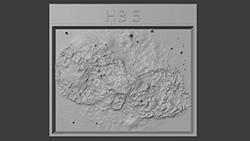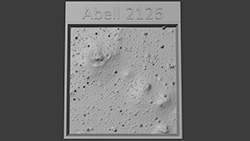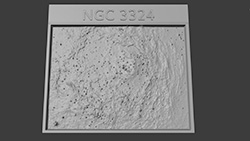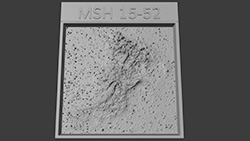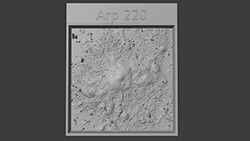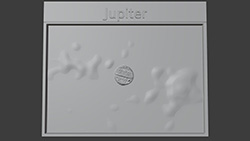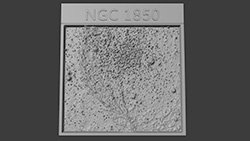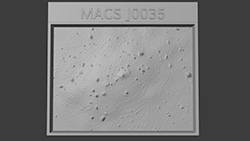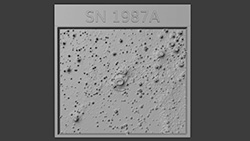CXC Home | Search | Help | Image Use Policy | Latest Images | Privacy | Accessibility | Glossary | Q&A
25 New Images for Chandra's 25th Anniversary
These images were released to commemorate the 25th anniversary of Chandra. They represent the wide range of objects that the telescope has observed over its quarter century of observations. X-rays are an especially penetrating type of light that reveals extremely hot objects and very energetic physical processes. The images range from supernova remnants, like Cassiopeia A or G21, to star-formation regions like the Pillars of Creation or Orion Nebula, to the region at the center of the Milky Way. This montage also contains objects beyond our own Galaxy including other galaxies and galaxy clusters.
1
Crab NebulaCredit: X-ray: (Chandra) NASA/CXC/SAO, (IXPE) NASA/MSFC; Optical: NASA/ESA/STScI; Image Processing: NASA/CXC/SAO/J. Schmidt, K. Arcand, and L. Frattare
The Crab Nebula is the result of a bright supernova explosion witnessed by Chinese and other astronomers in 1054 A.D. Chandra sees the rings around the pulsar and the jets blasting into space. X-rays from Chandra (blue-violet and white) and IXPE (purple); optical from Hubble (red, green, and blue)
Visual Description:
This composite image features the remnant of a supernova explosion, which resembles a neon purple mushroom at the heart of a colorful web of veins and filaments. Known as the Crab Nebula, the heavily veined blue and red cloud of gas is set against the blackness of space. At the core of the nebula is a pulsar, a rotating neutron star emitting electromagnetic radiation. Here, the pulsar appears as a bright white dot sitting in a neon purple cloud. Surrounding the dot are white rings. These are created by particles driven away from the pulsar and colliding with gas in the nebula to produce X-rays. From this angle, the rings and purple cloud combine to resemble a mushroom cap. Completing the look of a mushroom is a thin mushroom stem emerging from the white dot. This is a narrow beam of particles blasting away from the pulsar.
 Text
Text
 Audio
Audio
This composite image features the remnant of a supernova explosion, which resembles a neon purple mushroom at the heart of a colorful web of veins and filaments. Known as the Crab Nebula, the heavily veined blue and red cloud of gas is set against the blackness of space. At the core of the nebula is a pulsar, a rotating neutron star emitting electromagnetic radiation. Here, the pulsar appears as a bright white dot sitting in a neon purple cloud. Surrounding the dot are white rings. These are created by particles driven away from the pulsar and colliding with gas in the nebula to produce X-rays. From this angle, the rings and purple cloud combine to resemble a mushroom cap. Completing the look of a mushroom is a thin mushroom stem emerging from the white dot. This is a narrow beam of particles blasting away from the pulsar.
2
Orion NebulaCredit: X-ray: NASA/CXC/SAO; Infrared: NASA/ESA/CSA/STScI/M. Mccaughrean, S. Pearson; Image Processing: NASA/CXC/SAO/K. Arcand and J. Major
One of the closest regions of star formation to Earth, newly-formed stars in the Orion Nebula are detected by Chandra. X-rays from Chandra (magenta) and infrared from Webb (red, green, and blue).
Visual Description:
In this composite image, a collection of neon pink and white stars gleam through a haze of wispy clouds. The young stars range in size from tiny specks to plump circles. Many have white cores and are surrounded by neon pink rings, identifying stars detected by Chandra. Some display long, ruler-straight diffraction spikes. Near the upper right of the image is a burst of red cloud that resembles a thick shock of hair. Both the red burst and the collection of stars are muted by hazy clouds, as if viewed through wafting smoke rising out of a campfire.
 Text
Text
 Audio
Audio
In this composite image, a collection of neon pink and white stars gleam through a haze of wispy clouds. The young stars range in size from tiny specks to plump circles. Many have white cores and are surrounded by neon pink rings, identifying stars detected by Chandra. Some display long, ruler-straight diffraction spikes. Near the upper right of the image is a burst of red cloud that resembles a thick shock of hair. Both the red burst and the collection of stars are muted by hazy clouds, as if viewed through wafting smoke rising out of a campfire.
3
The Eyes Galaxies (NGC 4438 & 4435)Credit: X-ray: NASA/CXC/SAO; Optical: ESO; Image processing: NASA/CXC/SAO/J. Major
This system contains a pair of merging galaxies in the Virgo Cluster and the multimillion-degree gas emits X-rays detected by Chandra. X-rays from Chandra (purple); optical from ESO (red, green, blue)
Visual Description:
This composite image features a pair of merging galaxies, each resembling a brilliant white dot, earning the pair the nickname ‘The Eyes’. Near our lower left is the galaxy NGC 4438. This bright white dot is surrounded by a neon purple cloud of hot gas seen with Chandra. An inky black cloud nestled in a vertical strip of haze partially blocks our view of the neon purple, superheated gas. At our upper right is the second galaxy, NGC 4435. This bright white dot is surrounded by a thin, neon purple ring. The galaxy sits in the center of a glowing white streak, at the heart of a misty white pool. Flecks of white and neon purple speckle the image, set against the blackness of space.
 Text
Text
 Audio
Audio
This composite image features a pair of merging galaxies, each resembling a brilliant white dot, earning the pair the nickname ‘The Eyes’. Near our lower left is the galaxy NGC 4438. This bright white dot is surrounded by a neon purple cloud of hot gas seen with Chandra. An inky black cloud nestled in a vertical strip of haze partially blocks our view of the neon purple, superheated gas. At our upper right is the second galaxy, NGC 4435. This bright white dot is surrounded by a thin, neon purple ring. The galaxy sits in the center of a glowing white streak, at the heart of a misty white pool. Flecks of white and neon purple speckle the image, set against the blackness of space.
4
The Cat's Paw Nebula (NGC 6334)Credit: X-ray: NASA/SAO/CXC; Optical and H-alpha: ESO/MPG; Infrared: NASA/JPL-CalTech/Spitzer; Image Processing: J. Major
The Cat’s Paw is a nebula where stars are forming in the Milky Way galaxy. X-rays from Chandra show populations of young stars. X-rays from Chandra (purple); optical and H-alpha from ESO/MPG (red, green, and blue); infrared from Spitzer (red, green, and blue)
Visual Description:
In this composite image of the Cat’s Paw nebula, brilliant red and purple clouds blanket a black sky packed with stars. Throughout this star-forming region of the Milky Way, distinct pockets of glowing, brick red clouds are linked by wisps of purple. A cluster of the brightest stars in the image are found in the heart of the nebula. Many are neon purple, with glowing white dots at their core, representing young stars observed by Chandra.
 Text
Text
 Audio
Audio
In this composite image of the Cat’s Paw nebula, brilliant red and purple clouds blanket a black sky packed with stars. Throughout this star-forming region of the Milky Way, distinct pockets of glowing, brick red clouds are linked by wisps of purple. A cluster of the brightest stars in the image are found in the heart of the nebula. Many are neon purple, with glowing white dots at their core, representing young stars observed by Chandra.
5
The Milky Way's Galactic CenterCredit: X-ray: NASA/CXC/UMass/Q.D. Wang; Radio: NRF/SARAO/MeerKAT; Image processing: NASA/CXC/SAO/N. Wolk
The center of our Milky Way is blocked by gas and dust in many types of light, but X-rays can penetrate and reveal threads of superheated gas and bursts from our galaxy’s supermassive black hole. X-rays from Chandra (orange, green, blue, and purple); radio image from MeerKAT (lilac)
Visual Description:
This composite image depicting the center of our Milky Way galaxy features a row of bright spots and translucent swirls, set against a backdrop of purple and red clouds and stars. The clouds show hot gas seen with Chandra. The translucent threads, which are mysterious sources of radio waves, create clusters, streaks, and ribbons. Several of these distinct shapes resemble smoke trails captured on film. While most of the distinct swirls and bright spots sit in an orderly row across the middle of the image, one very bright spot sits at our lower righthand corner. This is the area around Sagittarius C, a bright star forming region, which here resembles a golden white orb ringed with hints of green.
 Text
Text
 Audio
Audio
This composite image depicting the center of our Milky Way galaxy features a row of bright spots and translucent swirls, set against a backdrop of purple and red clouds and stars. The clouds show hot gas seen with Chandra. The translucent threads, which are mysterious sources of radio waves, create clusters, streaks, and ribbons. Several of these distinct shapes resemble smoke trails captured on film. While most of the distinct swirls and bright spots sit in an orderly row across the middle of the image, one very bright spot sits at our lower righthand corner. This is the area around Sagittarius C, a bright star forming region, which here resembles a golden white orb ringed with hints of green.
6
M16 (Eagle Nebula)Credit: X-ray: NASA/CXO/SAO; Infrared: NASA/ESA/CSA/STScI; Image processing: NASA/CXC/SAO/L. Frattare
This region of star formation contains the Pillars of Creation, which was made famous by the Hubble Space Telescope. Chandra detects X-rays from young stars in the region, including one embedded in a pillar. X-rays from Chandra (red and blue); infrared image from Webb (red, green, and blue)
Visual Description:
This composite image features a region of star formation known as the Pillars of Creation. Here, tall columns of grey gas and dust emerge from the bottom edge of the image, stretching toward our upper right. Backed by dark orange and pink mist, the cloudy grey columns are surrounded by dozens of soft, glowing, dots in whites, reds, blues, yellows, and purples. These dots are young stars emitting X-ray and infrared light. Churning with turbulent gas and dust, the columns lean to our right with small offshoots pointing in the same direction. The misty glow, colorful stars, and lifelike grey dust formations combine to create an image of yearning cloud creatures at dusk, reaching for something just out of frame.
 Text
Text
 Audio
Audio
This composite image features a region of star formation known as the Pillars of Creation. Here, tall columns of grey gas and dust emerge from the bottom edge of the image, stretching toward our upper right. Backed by dark orange and pink mist, the cloudy grey columns are surrounded by dozens of soft, glowing, dots in whites, reds, blues, yellows, and purples. These dots are young stars emitting X-ray and infrared light. Churning with turbulent gas and dust, the columns lean to our right with small offshoots pointing in the same direction. The misty glow, colorful stars, and lifelike grey dust formations combine to create an image of yearning cloud creatures at dusk, reaching for something just out of frame.
7
Bat Shadow (Serpens Cloud)Credit: X-ray: NASA/CXC/SAO; Optical: NASA/ESA/STScI; Image Processing: NASA/CXC/SAO/J. Major
A young star with a planet forming disk is casting a shadow in the shape of a bat across a more distant cloud behind it. X-rays from Chandra (purple); optical image from Hubble (red, green, and blue)
Visual Description:
In this composite image, several pink and white stars gleam through murky cloud formations. These are young stars detected by Chandra. At our lower right, an opaque cloud resembling a veined slug rises out of a muddy brown mist. Blue and grey clouds with hints of brown stretch from our lower left, to our upper right. There, near the upper righthand corner, two long black triangles appear to burst from a central gleaming star. These triangles are in fact shadows from the young star, cast on distant blue and grey clouds. The eerie shape, reminiscent of the Batman call sign projected against a cloudy Gotham sky, has earned the phenomenon the nickname The Bat Shadow.
 Text
Text
 Audio
Audio
In this composite image, several pink and white stars gleam through murky cloud formations. These are young stars detected by Chandra. At our lower right, an opaque cloud resembling a veined slug rises out of a muddy brown mist. Blue and grey clouds with hints of brown stretch from our lower left, to our upper right. There, near the upper righthand corner, two long black triangles appear to burst from a central gleaming star. These triangles are in fact shadows from the young star, cast on distant blue and grey clouds. The eerie shape, reminiscent of the Batman call sign projected against a cloudy Gotham sky, has earned the phenomenon the nickname The Bat Shadow.
8
NGC 7469Credit: X-ray: NASA/CXC/Xiamen Univ./X. Xu; Optical/Infrared: NASA/ESA/UVA, NRAO, SUNY at Stony Brook/A. S. Evans, Hubble Heritage–ESA/Hubble Collaboration; Infrared: NASA/ESA/CSA/L. Armus, A. S. Evans; Image Processing: NASA/CXC/SAO/J. Major
NGC 7469 is a spiral galaxy, seen face on, that contains a growing supermassive black hole. Chandra shows hot gas near the black hole. X-rays from Chandra (purple); optical/IR from Hubble (red, green, and blue); infrared image from Webb (red, green, and blue)
Visual Description:
This composite image features a spiral galaxy, viewed face on. Here, two blue and red speckled arms spiral around a black hole at the heart of the galaxy, known as NGC 7469. Faint clouds of pale blue mist trace the lines of the speckled arms, muting the colors in the image. Here, the black hole at the center of the galaxy is represented by a bright white dot encircled by a mottled, neon purple ring. This dot and ring represent X-ray emission from hot gas around the black hole. Due to the perfect face-on angle, six red diffraction spikes radiate from the glowing black hole, like laser beams.
 Text
Text
 Audio
Audio
This composite image features a spiral galaxy, viewed face on. Here, two blue and red speckled arms spiral around a black hole at the heart of the galaxy, known as NGC 7469. Faint clouds of pale blue mist trace the lines of the speckled arms, muting the colors in the image. Here, the black hole at the center of the galaxy is represented by a bright white dot encircled by a mottled, neon purple ring. This dot and ring represent X-ray emission from hot gas around the black hole. Due to the perfect face-on angle, six red diffraction spikes radiate from the glowing black hole, like laser beams.
9
Virgo Cluster (including M86)Credit: X-ray: (Chandra) NASA/CXC/SAO; (XMM) ESA; H-alpha: NoirLab/NSF/KPNO; Optical: SDSS; CalTech/Palomar; Image processing: NASA/CXC/SAO/J. Major and K. Arcand
Hot gas detected by Chandra is being pulled away from this elliptical galaxy as it moves through a galaxy cluster at about three million miles per hour. X-rays from Chandra (purple) and XMM-Newton (blue); optical images from Digitized Sky Survey (red, green, and blue) and Palomar (red, green, and blue)
Visual Description:
This composite image features approximately one dozen galaxies, set against a black backdrop dotted with tiny specks of light. Some of the galaxies resemble glowing white dots. Other galaxies resemble disks, or have glowing outer rings. These galaxies are part of a galaxy cluster containing over a thousand galaxies. To our right of center is a large white and pink dot surrounded by a neon purple streak. This is the galaxy M86 traveling through the cluster at about three million miles per hour. The neon purple streak represents hot gas detected with Chandra. This hot gas is being pulled from the traveling galaxy as it collides with hot gas in the cluster.
 Text
Text
 Audio
Audio
This composite image features approximately one dozen galaxies, set against a black backdrop dotted with tiny specks of light. Some of the galaxies resemble glowing white dots. Other galaxies resemble disks, or have glowing outer rings. These galaxies are part of a galaxy cluster containing over a thousand galaxies. To our right of center is a large white and pink dot surrounded by a neon purple streak. This is the galaxy M86 traveling through the cluster at about three million miles per hour. The neon purple streak represents hot gas detected with Chandra. This hot gas is being pulled from the traveling galaxy as it collides with hot gas in the cluster.
10
WR 124Credit: X-ray: NASA/CXC/SAO; Infrared: (Herschel) ESA/NASA/Caltech, (Spitzer) NASA/JPL/Caltech, (WISE) NASA/JPL/Caltech; Infrared: NASA/ESA/CSA/STScI/Webb ERO Production Team; Image processing: NASA/CXC/SAO/J. Major
WR 124 is a rare type of Wolf-Rayet star, a bright, massive star experiencing a short-lived phase in its evolution. A dense wind from the star may prevent the detection with Chandra of a neutron star companion. X-rays from Chandra (purple); infrared from Herschel, Spitzer, WISE (blue) and Webb (red, green, and blue)
Visual Description:
In this composite image, a bright, massive star, WR 124, gleams with diffraction spikes, surrounded by a churning wind cloud in reds and purples. With its dusty rose coloring, and the bright, gleaming star at its core, the wind cloud resembles the inside of a delicate flower with opening petals. Dozens of other bright stars surround WR 124, including white dots rimmed with neon purple, and gleaming white dots with cool blue diffraction spikes. The purple dots are stars detected with Chandra.
 Text
Text
 Audio
Audio
In this composite image, a bright, massive star, WR 124, gleams with diffraction spikes, surrounded by a churning wind cloud in reds and purples. With its dusty rose coloring, and the bright, gleaming star at its core, the wind cloud resembles the inside of a delicate flower with opening petals. Dozens of other bright stars surround WR 124, including white dots rimmed with neon purple, and gleaming white dots with cool blue diffraction spikes. The purple dots are stars detected with Chandra.
11
Supernova Remnant G21.5-0.9Credit: X-ray: NASA/CXC/SAO; Infrared: NASA/JPL/CalTech/Spitzer; Radio: NSF/NRAO/VLA; Image Processing: NASA/CXC/SAO/L. Frattare
This supernova remnant, the debris from an exploded star, shows a bright nebula in the center surrounded by a much larger diffuse cloud of X-rays. X-rays from Chandra (purple and orange); infrared from Spitzer (yellow); radio from VLA (yellow)
Visual Description:
This composite image depicts a supernova remnant, which has a bright nebula at its core, surrounded by a cloud of X-rays detected with Chandra. Here, the nebula is represented by a small golden yellow dot at the center of the image. The dot appears to hover inside a tangle of light blue veins, which resemble a lightning cluster. Enveloping the nebula is the massive x-ray cloud, which occupies much of the image. Round in shape, the diffuse X-ray cloud is shown here in mottled neon purple. It represents the debris from the star destroyed in the supernova explosion.
 Text
Text
 Audio
Audio
This composite image depicts a supernova remnant, which has a bright nebula at its core, surrounded by a cloud of X-rays detected with Chandra. Here, the nebula is represented by a small golden yellow dot at the center of the image. The dot appears to hover inside a tangle of light blue veins, which resemble a lightning cluster. Enveloping the nebula is the massive x-ray cloud, which occupies much of the image. Round in shape, the diffuse X-ray cloud is shown here in mottled neon purple. It represents the debris from the star destroyed in the supernova explosion.
12
Centaurus ACredit: X-ray: (Chandra) NASA/CXC/SAO, (IXPE) NASA/MSFC; Optical: ESO; Image Processing: NASA/CXC/SAO/K. Arcand, J. Major, and J. Schmidt
At the center of the Centaurus A galaxy is a supermassive black hole that sends enormous jets out into space, which are detected by Chandra. X-rays from Chandra (red, green, blue) and IXPE (red, green, and blue); optical from ESO/MPG 2.2m (red, green, and blue)
Visual Description:
In this composite image, a supermassive black hole at the center of the Centaurus A galaxy shoots an enormous jet of particles into a star-packed sky. Here, Centaurus A resembles an inky purple cloud sitting atop a translucent red cloud. At the heart of the combined cloud structure is the black hole, a brilliant white dot that lights the clouds from within. The jet emerges from this dot, a speckled white and purple beam shooting toward our upper left. Surrounding the entire galaxy is a faint translucent blue bubble shape, which is most pronounced at our lower right. This bubble was created by the jets from the black hole. Both the jets and the bubble are detected by Chandra.
 Text
Text
 Audio
Audio
In this composite image, a supermassive black hole at the center of the Centaurus A galaxy shoots an enormous jet of particles into a star-packed sky. Here, Centaurus A resembles an inky purple cloud sitting atop a translucent red cloud. At the heart of the combined cloud structure is the black hole, a brilliant white dot that lights the clouds from within. The jet emerges from this dot, a speckled white and purple beam shooting toward our upper left. Surrounding the entire galaxy is a faint translucent blue bubble shape, which is most pronounced at our lower right. This bubble was created by the jets from the black hole. Both the jets and the bubble are detected by Chandra.
13
Cassiopeia ACredit: X-ray: NASA/CXC/SAO; Infrared: NASA/ESA/CSA/STScI/D. Milisavljevic (Purdue Univ.), I. De Looze (UGent), T. Temim (Princeton Univ.); Image Processing: NASA/CXC/SAO/J. Schmidt, K. Arcand, and J. Major
The Cassiopeia A supernova remnant has been observed for more than 2 million seconds since the start of the Chandra mission in 1999. X-rays from Chandra (blue); infrared from Webb (orange, white, and blue)
Visual Description:
This image features the Cassiopeia A supernova, an expanding ball of matter and energy ejected from an exploding star. Here, rings of neon blue and brilliant white emit veins of polished gold. The rings and their arching veins encircle a place of relative calm at the center of the supernova remnant. This hole at the center of the circle, and the three-dimensionality conveyed by the rings and their arching veins, give this image of Cassiopeia A the look of a giant, crackling, electric blue donut. X-rays detected by Chandra show debris from the destroyed star and the blast wave from the explosion.
 Text
Text
 Audio
Audio
This image features the Cassiopeia A supernova, an expanding ball of matter and energy ejected from an exploding star. Here, rings of neon blue and brilliant white emit veins of polished gold. The rings and their arching veins encircle a place of relative calm at the center of the supernova remnant. This hole at the center of the circle, and the three-dimensionality conveyed by the rings and their arching veins, give this image of Cassiopeia A the look of a giant, crackling, electric blue donut. X-rays detected by Chandra show debris from the destroyed star and the blast wave from the explosion.
14
NGC 3532Credit: X-ray: NASA/CXC/SAO; Optical: ESO; Image Processing: NASA/CXC/SAO/J. Major
NGC 3532 (also called the “Wishing Well Cluster”) is a cluster of middle-aged stars — about 300 million years old — that covers nearly twice the size of the full Moon on the sky. X-rays from Chandra (purple and white); optical from ESO/MPG 2.2m (red, green, and blue)
Visual Description:
This image of the NGC 3532 star cluster resembles a black canvas stippled with thousands of drops of colorful paint, flicked from an artist’s brush. From this vantage point, the stars range from minuscule to merely tiny. They range in color from white and golden yellow, to oranges, reds, blues and purples. Some of the stars have white cores with colorful outlines, while others gleam and have large, translucent, outer glows. The purple and white stars are those detected in X-rays by Chandra. A faint, hazy, brick orange cloud streaks across the middle of the image.
 Text
Text
 Audio
Audio
This image of the NGC 3532 star cluster resembles a black canvas stippled with thousands of drops of colorful paint, flicked from an artist’s brush. From this vantage point, the stars range from minuscule to merely tiny. They range in color from white and golden yellow, to oranges, reds, blues and purples. Some of the stars have white cores with colorful outlines, while others gleam and have large, translucent, outer glows. The purple and white stars are those detected in X-rays by Chandra. A faint, hazy, brick orange cloud streaks across the middle of the image.
15
NGC 6872Credit: X-ray: NASA/CXC/SAO; Optical: NASA/ESA/STScI; Image Processing: NASA/CXC/SAO/J. Schmidt, L. Frattare, and J. Major
The barred spiral galaxy NGC 6872 is interacting with a smaller galaxy to the upper left. The smaller galaxy has likely stripped gas from NGC 6872 to feed the supermassive black hole in its center. X-rays from Chandra (purple); optical from Hubble (red, green, and blue)
Visual Description:
In this composite image, a large spiral galaxy has some of its superheated gas stolen by a smaller, nearby neighbor. Centered in the frame, NGC 6872 is a large spiral galaxy with two elongated arms that stretch toward our upper right and lower left. Near the white dot at the heart of the galaxy, a cloud of neon purple tints the arms, which appear steel blue at the tips. The purple represents hot gas detected by Chandra. Just to the upper left of NGC 6872 is a second spiral galaxy. Its spiraling arms are much smaller, but the bright white dot at its core is quite large, suggesting a supermassive black hole. Some of the steel blue matter and gas from NGC 6872’s lower arm appears to be floating toward the smaller galaxy, likely pulled toward the supermassive black hole.
 Text
Text
 Audio
Audio
In this composite image, a large spiral galaxy has some of its superheated gas stolen by a smaller, nearby neighbor. Centered in the frame, NGC 6872 is a large spiral galaxy with two elongated arms that stretch toward our upper right and lower left. Near the white dot at the heart of the galaxy, a cloud of neon purple tints the arms, which appear steel blue at the tips. The purple represents hot gas detected by Chandra. Just to the upper left of NGC 6872 is a second spiral galaxy. Its spiraling arms are much smaller, but the bright white dot at its core is quite large, suggesting a supermassive black hole. Some of the steel blue matter and gas from NGC 6872’s lower arm appears to be floating toward the smaller galaxy, likely pulled toward the supermassive black hole.
16
Hb 5Credit: X-ray: NASA/CXC/SAO; Optical: NASA/ESA/STScI; Radio: NSF/ESO/NRAO/ALMA/RIT (P. Moraga Baez, J. Kastner); Image Processing: NASA/CXC/SAO/K. Arcand, J. Major
Planetary nebula HB 5, an end phase of a Sun-like star, was discovered by famous astronomer Edwin Hubble. X-rays from hot gas in HB 5 are detected by Chandra. X-rays from Chandra (blue and white); optical from Hubble (red, purple, blue); radio image from ALMA (yellow and white)
Visual Description:
This composite image of the planetary nebula HB 5 resembles a bulbous bow tie in mottled purples. This is a Sun-like star towards the end of its life. At the heart of the nebula, or the brilliant golden white knot of the bow tie, is a recent mass ejection from the dying star. To its right and left are matching bulbous spheres of churning purple gas. Each sphere of gas is several times larger than the exploding knot between them. Also present in the nebula are faint clouds in neon blue and mustard yellow. The blue cloud, most prominent at our upper left, represents X-rays observed by Chandra. The mustard yellow cloud, which highlights the star’s recent mass ejection, represents carbon monoxide gas observed in radio waves by ALMA.
 Text
Text
 Audio
Audio
This composite image of the planetary nebula HB 5 resembles a bulbous bow tie in mottled purples. This is a Sun-like star towards the end of its life. At the heart of the nebula, or the brilliant golden white knot of the bow tie, is a recent mass ejection from the dying star. To its right and left are matching bulbous spheres of churning purple gas. Each sphere of gas is several times larger than the exploding knot between them. Also present in the nebula are faint clouds in neon blue and mustard yellow. The blue cloud, most prominent at our upper left, represents X-rays observed by Chandra. The mustard yellow cloud, which highlights the star’s recent mass ejection, represents carbon monoxide gas observed in radio waves by ALMA.
17
Abell 2125Credit: X-ray: NASA/CXC/SAO; Optical: NSF/NOIRLab/KPNO/F. Owen; Image Processing: NASA/CXC/SAO/J. Major, K. Arcand
There are several clouds of superheated gas, seen by Chandra, that are merging in the Abell 2125 galaxy cluster. X-rays from Chandra (purple and white); optical from Kitt Peak (gold)
Visual Description:
In this composite image of the Abell 2125 galaxy cluster, several clouds of superheated gas surround a bright, gleaming galaxy. Here, the entire image is speckled with glowing golden yellow and neon purple dots, individual galaxies within the cluster. At the center of the frame is the largest and brightest dot, a golden galaxy emitting four diffraction spikes. Surrounding this galaxy are translucent neon purple gas clouds, representing X-rays observed by Chandra. Faint pockets of X-ray gas are found throughout the image, but the most prominent clouds flank the central galaxy at our upper left and lower right.
 Text
Text
 Audio
Audio
In this composite image of the Abell 2125 galaxy cluster, several clouds of superheated gas surround a bright, gleaming galaxy. Here, the entire image is speckled with glowing golden yellow and neon purple dots, individual galaxies within the cluster. At the center of the frame is the largest and brightest dot, a golden galaxy emitting four diffraction spikes. Surrounding this galaxy are translucent neon purple gas clouds, representing X-rays observed by Chandra. Faint pockets of X-ray gas are found throughout the image, but the most prominent clouds flank the central galaxy at our upper left and lower right.
18
NGC 3324Credit: X-ray: NASA/CXC/Ludwig Maximilian Univ./T. Preibisch et al.; Infrared: NASA/ESA/CSA/STScI; Image processing: NASA/CXC/SAO/N. Wolk
Astronomers nicknamed this region of star formation the “Cosmic Cliffs,” which is found in the nearby Carina Nebula. X-rays from young stars in two clusters are detected by Chandra. X-rays from Chandra (purple); infrared from Webb (yellow, green, cyan, and blue)
Visual Description:
This composite image features two star clusters, viewed through a churning tunnel of golden cloud. The cloud creates a border around the entire image, like a thick swirling smoke ring. Beyond it, in the open center, is a vast field of neon purple specks. These specks are young stars observed by Chandra. Within the central field, two cluster groupings are suggested by separate swirls of faint, steel blue mist. One sits near our upper right. The other is near the bottom left, partially obscured by the golden yellow ring cloud.
 Text
Text
 Audio
Audio
This composite image features two star clusters, viewed through a churning tunnel of golden cloud. The cloud creates a border around the entire image, like a thick swirling smoke ring. Beyond it, in the open center, is a vast field of neon purple specks. These specks are young stars observed by Chandra. Within the central field, two cluster groupings are suggested by separate swirls of faint, steel blue mist. One sits near our upper right. The other is near the bottom left, partially obscured by the golden yellow ring cloud.
19
NGC 1365X-ray: NASA/CXC/SAO; Optical: ESO/VLT; Infrared: NASA/ESA/STScI/JWST/PHANGS; Image Processing: NASA/CXC/SAO/L. Frattare, J. Major
This spiral galaxy contains a supermassive black hole and stars rapidly forming in its center. Chandra sees X-rays from gas near the massive black hole and from smaller black holes or neutron stars pulling material from companion stars. X-rays from Chandra (blue); optical from VLT (yellow and blue); infrared from Webb (red, green, and blue)
Visual Description:
This composite image features a close look at the supermassive black hole at the heart of the spiral galaxy known as NGC 1365. The brilliant black hole glows white at the center of the image, its outer edges tinted bright blue. From this core, two thick ropey red arms spiral out. Continuing their spiral curves, the arms extend well beyond the edges of the frame. Dotting the image are a series of white spots with neon blue outer edges. These are stars paired with smaller black holes or neutron stars, observed by Chandra.
 Text
Text
 Audio
Audio
This composite image features a close look at the supermassive black hole at the heart of the spiral galaxy known as NGC 1365. The brilliant black hole glows white at the center of the image, its outer edges tinted bright blue. From this core, two thick ropey red arms spiral out. Continuing their spiral curves, the arms extend well beyond the edges of the frame. Dotting the image are a series of white spots with neon blue outer edges. These are stars paired with smaller black holes or neutron stars, observed by Chandra.
20
MSH 15-52Credit: X-ray: NASA/CXC/SAO; Optical: NOIRLab/DECam; Image processing: NASA/CXC/SAO/J. Schmidt
Pulsar wind nebulas like MSH 15-52 are clouds of energetic particles, producing X-rays, that are driven away from dead collapsed stars. X-rays from Chandra (gold and blue); infrared from the Dark Energy Camera KPNO Blanco 4.0m (red and blue)
Visual Description:
In this composite image, a pulsar, a pulsar wind nebula, and a low energy X-ray cloud combine to create an uncanny scene of a skeletal hand preparing to grab a glowing ember. The hand reaches up from the bottom of the image, the ghostly blue flesh and white bones representing pulsar wind nebula X-rays observed by Chandra. A bright white spot in the wrist is the pulsar itself. Just beyond the hand’s fingertips, near our upper right, is a mottled yellow and orange shape that appears to glow from within. This is the low energy X-ray cloud observed by Chandra.
 Text
Text
 Audio
Audio
In this composite image, a pulsar, a pulsar wind nebula, and a low energy X-ray cloud combine to create an uncanny scene of a skeletal hand preparing to grab a glowing ember. The hand reaches up from the bottom of the image, the ghostly blue flesh and white bones representing pulsar wind nebula X-rays observed by Chandra. A bright white spot in the wrist is the pulsar itself. Just beyond the hand’s fingertips, near our upper right, is a mottled yellow and orange shape that appears to glow from within. This is the low energy X-ray cloud observed by Chandra.
21
Arp 220Credit: X-ray: NASA/CXC/SAO; Optical: NASA/ESA/STScI; Infrared: NASA/ESA/CSA/STScI; Image Processing: NASA/CXC/SAO/L. Frattare, J. Major
Chandra observations of Arp 220 give insight into what happens when two galaxies about the size of the Milky Way collide. X-rays from Chandra (purple); optical and infrared from Hubble (red, green, and blue)
Visual Description:
This composite image features an ultra-luminous infrared galaxy, surrounded by a soft, rose-pink cloud of X-ray gas. Named Arp 220, this galaxy is the result of a collision between two galaxies, each about the size of our own Milky Way. Here, a single, bright, golden white dot sits at the center of the image. The rose-pink cloud surrounding the dot appears soft and airy, like cotton candy. Upon close inspection, feint orange veins can be discerned, marbling the X-ray gas cloud seen with Chandra. Surrounding the gas cloud are other distant galaxies and stars, set against the blackness of space. Most are orange or white, and range from tiny specks to small glowing ovals.
 Text
Text
 Audio
Audio
This composite image features an ultra-luminous infrared galaxy, surrounded by a soft, rose-pink cloud of X-ray gas. Named Arp 220, this galaxy is the result of a collision between two galaxies, each about the size of our own Milky Way. Here, a single, bright, golden white dot sits at the center of the image. The rose-pink cloud surrounding the dot appears soft and airy, like cotton candy. Upon close inspection, feint orange veins can be discerned, marbling the X-ray gas cloud seen with Chandra. Surrounding the gas cloud are other distant galaxies and stars, set against the blackness of space. Most are orange or white, and range from tiny specks to small glowing ovals.
22
JupiterCredit: X-ray: NASA/CXC/SAO; Infrared: NASA/ESA/CSA/STScI; Image Processing: NASA/CXC/SAO/J. Major, S. Wolk
The fifth planet from the Sun and largest in the Solar System and known to have X-ray-producing aurora around its poles. X-rays from Chandra (purple); infrared from Hubble (red, green, and blue)
Visual Description:
In this composite image of Jupiter, the fifth planet from the sun is set against the blackness of space, flanked by neon purple blobs. Here, Jupiter is presented in exceptionally clear focus. More than a dozen bands of swirling gas streak the surface, each a different texture and shade of grey. The gas giant is encircled by a fine, sky-blue ring, the same color as the large storm which swirls on its surface at our lower right. At the top edge of Jupiter, tilted just to our right of center, is a neon purple strip. A similar, smaller line of neon purple can be found at the bottom edge of the planet. Capping the planet’s magnetic poles, these purple strips represent X-ray auroras, created when high-energy particles collide with gas in the planet’s atmosphere. At our right and left, large hazy blobs of neon purple flank Jupiter, some larger than the gas giant itself. Like the auroras, these purple clouds represent X-rays observed by Chandra.
 Text
Text
 Audio
Audio
In this composite image of Jupiter, the fifth planet from the sun is set against the blackness of space, flanked by neon purple blobs. Here, Jupiter is presented in exceptionally clear focus. More than a dozen bands of swirling gas streak the surface, each a different texture and shade of grey. The gas giant is encircled by a fine, sky-blue ring, the same color as the large storm which swirls on its surface at our lower right. At the top edge of Jupiter, tilted just to our right of center, is a neon purple strip. A similar, smaller line of neon purple can be found at the bottom edge of the planet. Capping the planet’s magnetic poles, these purple strips represent X-ray auroras, created when high-energy particles collide with gas in the planet’s atmosphere. At our right and left, large hazy blobs of neon purple flank Jupiter, some larger than the gas giant itself. Like the auroras, these purple clouds represent X-rays observed by Chandra.
23
NGC 1850Credit: X-ray: NASA/CXC/SAO; Optical: NASA/ESA/STScI; Infrared: NASA/JPL/CalTech/Spitzer; Image Processing: NASA/CXC/SAO/J. Major, K. Arcand
NGC 1850 is a bright, double star cluster that lies in the Large Magellanic Cloud, a small neighbor galaxy to the Milky Way. It contains a black hole with a mass of about 11 Suns, and a companion star. No clear detection of X-rays with Chandra implies that the black hole is not quickly pulling material away from its companion. X-rays from Chandra (magenta); optical from Hubble (red, yellow, green, cyan, blue); infrared from Spitzer (red)
Visual Description:
This composite image features a double star cluster, a blue-tinted cloud, and several neon purple dots. This double cluster is part of the Large Magellanic Cloud, a companion galaxy to the Milky Way. The bright, golden stars in the larger cluster fill the upper center of the image. The other cluster is much smaller and coincides with one of the neon purple circles located slightly above and to the right of the image’s center. This and the other purple circles are X-ray sources detected with Chandra. To our left of the combined cluster is a vertical streak of blue-tinted cloud. Extending beyond the upper and lower edges of the image, this section of cloud resembles wafting smoke from a cigarette.
 Text
Text
 Audio
Audio
This composite image features a double star cluster, a blue-tinted cloud, and several neon purple dots. This double cluster is part of the Large Magellanic Cloud, a companion galaxy to the Milky Way. The bright, golden stars in the larger cluster fill the upper center of the image. The other cluster is much smaller and coincides with one of the neon purple circles located slightly above and to the right of the image’s center. This and the other purple circles are X-ray sources detected with Chandra. To our left of the combined cluster is a vertical streak of blue-tinted cloud. Extending beyond the upper and lower edges of the image, this section of cloud resembles wafting smoke from a cigarette.
24
MACS J0035Credit: X-ray: NASA/CXC/SAO; Optical: NASA/ESA/STScI; Image Processing: NASA/CXC/SAO/J. Major
Galaxy clusters like MACS J0035 are the largest structures in the Universe held together by gravity. They contain huge amounts of hot gas that produces X-rays seen with X-ray telescopes like Chandra. X-rays from Chandra (purple); optical from Hubble (gold)
Visual Description:
This composite image features dozens of tiny golden specks, each a distinct galaxy. The cluster, known as MACS J0035, is surrounded by a hazy, purple, cloud of hot gas detected by Chandra. From this distance, most of the galaxies in the cluster resemble glowing specks and very short streaks. However, upon close inspection, some of the oblong specks and streaks are revealed to have spiral arms.
 Text
Text
 Audio
Audio
This composite image features dozens of tiny golden specks, each a distinct galaxy. The cluster, known as MACS J0035, is surrounded by a hazy, purple, cloud of hot gas detected by Chandra. From this distance, most of the galaxies in the cluster resemble glowing specks and very short streaks. However, upon close inspection, some of the oblong specks and streaks are revealed to have spiral arms.
25
SN 1987ACredit: X-ray: NASA/CXC/SAO; Optical/Infrared: NASA/ESA/STScI; Infrared: NASA/ESA/CSA/STScI; Image Processing: NASA/CXC/SAO/J. Major
The supernova explosion that created this object was first observed on Earth in February 1987. Chandra sees X-rays produced by debris from the explosion. X-rays from Chandra (purple); optical and infrared from Hubble (red, green, blue); infrared from Webb (red, green, and blue)
Visual Description:
At the center of this composite image is a small object resembling a glowing pink Cheerio. This is supernova SN 1987A, named after the year the core-collapse explosion was first observed on Earth. It is located in the Large Magellanic Cloud, a small nearby galaxy. The pink Cheerio, or equatorial ring, represents material ejected tens of thousands of years before the supernova explosion. The blast wave from the supernova is striking the ring, causing it to produce X-rays detected by Chandra. Inside this ring is a pale, steel blue dot containing debris from the star that exploded.. The ring sits at the center of a ghostly figure 8, outlined in brick orange. This entire structure is surrounded by a packed field of stars, specks and dots in white, blue, and orange. A long, brick orange cloud hovers near the left edge of the image.
 Text
Text
 Audio
Audio
At the center of this composite image is a small object resembling a glowing pink Cheerio. This is supernova SN 1987A, named after the year the core-collapse explosion was first observed on Earth. It is located in the Large Magellanic Cloud, a small nearby galaxy. The pink Cheerio, or equatorial ring, represents material ejected tens of thousands of years before the supernova explosion. The blast wave from the supernova is striking the ring, causing it to produce X-rays detected by Chandra. Inside this ring is a pale, steel blue dot containing debris from the star that exploded.. The ring sits at the center of a ghostly figure 8, outlined in brick orange. This entire structure is surrounded by a packed field of stars, specks and dots in white, blue, and orange. A long, brick orange cloud hovers near the left edge of the image.
Tactile Products
1
Crab Nebula(3D Print Credit: NASA/CXC/A. Jubett, using software by Tactile Universe/N. Bonne & C. Krawczyk & Blender)
This tactile plate is a physical relief map based on the intensity of X-ray data from Chandra and IXPE, and optical data from Hubble. It features the remnant of a supernova explosion, which resembles a mushroom at the heart of a web of veins and filaments. Known as the Crab Nebula, the heavily veined cloud of gas fills most of the space on the plate, with the mushroom-shaped nebula at its center. At the core of the nebula is a pulsar, a rotating neutron star emitting electromagnetic radiation. Here, the pulsar presents as a raised dot sitting in the middle of the plate. Surrounding the dot are rings. These are created by particles driven away from the pulsar and colliding with gas in the nebula to produce X-rays. From this angle, the rings and cloud combine to resemble a mushroom cap. Completing the shape of a mushroom is a thin mushroom stem emerging from the dot. This is a narrow beam of particles blasting away from the pulsar.
2
Orion Nebula(3D Print Credit: NASA/CXC/A. Jubett, using software by Tactile Universe/N. Bonne & C. Krawczyk & Blender)
This tactile plate is a physical relief map based on the intensity of X-ray and infrared data. In this composite plate, a collection of points representing stars poke through a haze of wispy clouds. The young stars range in size from tiny specks to plump circles. Many have raised cores, and are surrounded by less-distinct rings, identifying stars detected by Chandra. Some display long, ruler-straight diffraction spikes. Near the upper right of the plate is a burst of cloud that resembles a thick shock of hair. Both the cloud burst and the collection of stars are smoothed by hazy clouds, as if felt through a thick piece of fabric.
3
The Eyes Galaxies (NGC 4438 & 4435)(3D Print Credit: NASA/CXC/A. Jubett, using software by Tactile Universe/N. Bonne & C. Krawczyk & Blender)
This tactile plate is a physical relief map based on the intensity of X-ray and optical data, featuring a pair of merging galaxies, each presenting as a raised mass, earning the pair the nickname ‘The Eyes’. Near our lower left is the galaxy NGC 4438. The most prominent dot is surrounded by a clumpy cloud of hot gas seen with Chandra. A cloud nestled in a vertical strip of haze partially blocks the regular shape of the superheated gas. At our upper right is the second galaxy, NGC 4435. This jutting dot is surrounded by a thin, raised ring. The galaxy sits in the center of a streak, at the heart of a plateaued pool. Flecks of pointed dots speckle the plate, set against the vastness of space.
4
The Cat's Paw Nebula (NGC 6334)(3D Print Credit: NASA/CXC/A. Jubett, using software by Tactile Universe/N. Bonne & C. Krawczyk & Blender)
This tactile plate is a physical relief map based on the intensity of X-ray, infrared and optical data. In this composite plate of the Cat’s Paw nebula, clumps of clouds blanket a sky packed with stars. Throughout this star-forming region of the Milky Way, distinct pockets of clouds are linked by wispy ridges. A cluster of the brightest stars in the image are found in the heart of the nebula. Many are quite prominent, with raised dots at their core, representing young stars observed by Chandra.
5
The Milky Way's Galactic Center(3D Print Credit: NASA/CXC/A. Jubett, using software by Tactile Universe/N. Bonne & C. Krawczyk & Blender)
This tactile plate is a physical relief map based on the intensity of X-ray and radio data. The composite plate depicts the center of our Milky Way galaxy, featuring a row of spots and swirls, set against a backdrop of clouds and stars. The clouds show hot gas seen with Chandra. Threads, which are mysterious sources of radio waves, create clusters, streaks, and ribbons. Several of these distinct shapes resemble lingering spark trails from a fire. While most of the distinct swirls and spots sit in an orderly row across the middle of the plate, one very raised spot sits at our lower righthand corner, quite large in diameter. This is the area around Sagittarius C, a bright star forming region, which here resembles a mesa jutting out of the prairie.
6
M16 (Eagle Nebula)(3D Print Credit: NASA/CXC/A. Jubett, using software by Tactile Universe/N. Bonne & C. Krawczyk & Blender)
This tactile plate is a physical relief map based on the intensity of Chandra X-ray and Webb infrared data, featuring a region of star formation known as the Pillars of Creation. Here, tall columns of gas and dust emerge from the bottom edge of the plate, stretching toward our upper right. Backed by mist, the cloudy columns are surrounded by dozens of soft, dots of various sizes. These dots are young stars emitting X-ray and infrared light. Churning with turbulent gas and dust, the columns lean to our right with small offshoots pointing in the same direction. The mist, stars, and lifelike dust formations combine to create a row of yearning cloud creatures at dusk, reaching for something just out of frame.
7
Bat Shadow (Serpens Cloud)(3D Print Credit: NASA/CXC/A. Jubett, using software by Tactile Universe/N. Bonne & C. Krawczyk & Blender)
This tactile plate is a physical relief map based on the intensity of X-ray and optical data. In this composite plate, several stars poke through murky cloud formations. These are young stars detected by Chandra. At our lower right, a clumpy cloud rises, ridge-like, out of a muddy mist. Other clouds stretch from our lower left, to our upper right. There, near the upper righthand corner, two long indented triangles appear to burst from a central protruding star. These triangles are in fact shadows from the young star, cast on distant clouds. The eerie shape, reminiscent of the Batman call sign projected against a cloudy Gotham sky, has earned the phenomenon the nickname The Bat Shadow.
8
NGC 7469(3D Print Credit: NASA/CXC/A. Jubett, using software by Tactile Universe/N. Bonne & C. Krawczyk & Blender)
This tactile plate is a physical relief map based on the intensity of X-ray, infrared and optical data. This composite plate features a spiral galaxy, situated face on. Here, two speckled arms spiral around a black hole at the heart of the galaxy, known as NGC 7469. Faintly raised clouds of mist trace the lines of the speckled arms, softening the ridges in the plate. Here, the black hole at the center of the galaxy is represented by a pointed dot encircled by a mottled ring. This dot and ring represent X-ray emission from hot gas around the black hole. Due to the perfect face-on angle, six raised diffraction spikes radiate from the protruding black hole, like laser beams.
9
Virgo Cluster (including M86)(3D Print Credit: NASA/CXC/A. Jubett, using software by Tactile Universe/N. Bonne & C. Krawczyk & Blender)
This tactile plate is a physical relief map based on the intensity of X-ray and optical data, featuring approximately one dozen galaxies, set against a backdrop dotted with tiny specks of light. Some of the galaxies resemble pointed, protruding dots. Other galaxies resemble disks, or have slightly raised outer rings. These galaxies are part of a galaxy cluster containing over a thousand galaxies. To our right of center is a large puffy dot surrounded by a ridged streak. This is the galaxy M86 traveling through the cluster at about three million miles per hour. The streak represents hot gas detected with Chandra. This hot gas is being pulled from the traveling galaxy as it collides with hot gas in the cluster.
10
WR 124(3D Print Credit: NASA/CXC/A. Jubett, using software by Tactile Universe/N. Bonne & C. Krawczyk & Blender)
This tactile plate is a physical relief map based on the intensity of X-ray and infrared data. In this composite plate, a prominent, massive star, WR 124, sits like a snowflake in the center of 6 diffraction spikes, surrounded by a churning wind cloud. The combination of the wind cloud with the spikes, dots and tangles of wisps resembles a puffy dandelion that has gone to seed. Dozens of other prominent stars surround WR 124, including dots rimmed with mounds of light, and other dots with raised diffraction spikes. The mounded dots are stars detected with Chandra.
11
Supernova Remnant G21.5-0.9(3D Print Credit: NASA/CXC/A. Jubett, using software by Tactile Universe/N. Bonne & C. Krawczyk & Blender)
This tactile plate is a physical relief map based on the intensity of X-ray and radio data. The composite plate depicts a supernova remnant, which has a raised nebula at its core, surrounded by a cloud of X-rays detected with Chandra. Here, the nebula is represented by a small protruding dot at the center of the plate. The dot appears to hover inside a tangle of clumpy veins, which resemble a lightning cluster. Enveloping the nebula is the massive x-ray cloud, which occupies much of the plate. Round in shape, the diffuse X-ray cloud is shown here in mottled streaked ridges. It represents the debris from the star destroyed in the supernova explosion.
12
Centaurus A(3D Print Credit: NASA/CXC/A. Jubett, using software by Tactile Universe/N. Bonne & C. Krawczyk & Blender)
This tactile plate is a physical relief map based on the intensity of X-ray and optical data. In this composite plate, a supermassive black hole at the center of the Centaurus A galaxy shoots an enormous jet of particles into a star-packed sky. Here, Centaurus A resembles layers of streaky clouds. At the heart of the combined cloud structure is the black hole, a protruding dot that lights the clouds from within. The jet emerges from this dot, a speckled beam shooting toward our upper left. Surrounding the entire galaxy is a bubble shape, which is most pronounced at our lower right. This bubble was created by the jets from the black hole. Both the jets and the bubble are detected by Chandra.
13
Cassiopeia A(3D Print Credit: NASA/CXC/A. Jubett, using software by Tactile Universe/N. Bonne & C. Krawczyk & Blender)
This tactile plate is a physical relief map based on the intensity of X-ray and infrared data. This plate features the Cassiopeia A supernova, an expanding ball of matter and energy ejected from an exploding star. Here, rings of ridges emit veins that push out radially from the center. The rings and their arching veins encircle a place of relative calm at the center of the supernova remnant. This hole at the center of the circle, and the three-dimensionality conveyed by the rings and their arching veins, give this plate of Cassiopeia A the shape of a giant, crackling donut. X-rays detected by Chandra show debris from the destroyed star and the blast wave from the explosion.
14
NGC 3532(3D Print Credit: NASA/CXC/A. Jubett, using software by Tactile Universe/N. Bonne & C. Krawczyk & Blender)
This tactile plate is a physical relief map based on the intensity of X-ray and optical data. This plate of the NGC 3532 star cluster resembles a canvas stippled with thousands of drops of thick paint, flicked from an artist’s brush. From this vantage point, the stars range from minuscule to merely tiny. Some of the stars have pointed cores with faint outlines, running into each other as a mottled overall background, while others protrude and have large outer glows. The stars with faint outlines are those detected in X-rays by Chandra. A faint, haze of cloud streaks across the middle of the plate.
15
NGC 6872(3D Print Credit: NASA/CXC/A. Jubett, using software by Tactile Universe/N. Bonne & C. Krawczyk & Blender)
This tactile plate is a physical relief map based on the intensity of X-ray and optical data. In this composite plate, a large spiral galaxy has some of its superheated gas stolen by a smaller, nearby neighbor. Centered in the frame, NGC 6872 is a large spiral galaxy with two elongated arms that stretch toward our upper right and lower left. Near the raised dot at the heart of the galaxy, a cloud surrounds the arms. This cloud represents hot gas detected by Chandra. Just to the upper left of NGC 6872 is a second spiral galaxy. Its spiraling arms are much smaller, but the raised dot at its core is quite large, suggesting a supermassive black hole. Some of the matter and gas from NGC 6872’s lower arm seems to be floating toward the smaller galaxy, likely pulled toward the supermassive black hole.
16
Hb 5(3D Print Credit: NASA/CXC/A. Jubett, using software by Tactile Universe/N. Bonne & C. Krawczyk & Blender)
This tactile plate is a physical relief map based on the intensity of X-ray, optical and radio data. This composite plate of the planetary nebula HB5 resembles a bulbous bow tie in mottled texture. At the heart of the nebula, or the knot of the bow tie, is a plateaued circle of explosion. This is a Sun-like star towards the end of its life. To its right and left are matching bulbous spheres of churning gas. Each sphere of gas is several times larger than the exploding knot between them. Also present in the nebula are faint clouds. The cloud most prominent at our upper left represents X-rays observed by Chandra. The other cloud, which surrounds the exploding star, represents radio waves observed by ALMA.
17
Abell 2125(3D Print Credit: NASA/CXC/A. Jubett, using software by Tactile Universe/N. Bonne & C. Krawczyk & Blender)
This tactile plate is a physical relief map based on the intensity of X-ray and optical data. In this composite plate of the Abell 2125 galaxy cluster, clouds of superheated gas surround a ball-shaped galaxy. Here, the entire plate is speckled with pointed dots, individual galaxies within the cluster. At the center of the frame is the largest dot, a galaxy surrounded by gas clouds, representing X-rays observed by Chandra. Faint pockets of X-ray gas are found throughout the plate, but the most prominent clouds flank the central galaxy at our upper left and lower right.
18
NGC 3324(3D Print Credit: NASA/CXC/A. Jubett, using software by Tactile Universe/N. Bonne & C. Krawczyk & Blender)
This tactile plate is a physical relief map based on the intensity of X-ray and infrared data. This composite plate features two star clusters, viewed through a churning tunnel of cloud. The cloud creates a border around the entire plate, like a thick swirling smoke ring. Beyond it, in the open center, is a vast field of specks. These specks are young stars observed by Chandra. Within the central field, two cluster groupings are suggested by separate swirls of faint mist. One sits near our upper right. The other is near the bottom left, partially obscured by the ring cloud.
19
NGC 1365(3D Print Credit: NASA/CXC/A. Jubett, using software by Tactile Universe/N. Bonne & C. Krawczyk & Blender)
This tactile plate is a physical relief map based on the intensity of X-ray, infrared and optical data. This composite plate features a close-up of the supermassive black hole at the heart of the spiral galaxy known as NGC 1365. The black hole pushes out of the plate at the center, its outer edges raised and mottled. From this core, two thick ropey arms spiral out. Continuing their spiral curves, the arms extend well beyond the edges of the frame. Dotting the plate are a series of pointed, cone-like spots. These are stars paired with smaller black holes or neutron stars, observed by Chandra.
20
MSH 15-52(3D Print Credit: NASA/CXC/A. Jubett, using software by Tactile Universe/N. Bonne & C. Krawczyk & Blender)
This tactile plate is a physical relief map based on the intensity of X-ray, infrared and optical data. In this composite plate, a pulsar, a pulsar wind nebula, and a low energy X-ray cloud combine to create an uncanny shape of a skeletal hand preparing to grab a glowing ember. The hand reaches up from the bottom of the plate, the ghostly bones representing pulsar wind nebula X-rays observed by Chandra. A raised spot in the wrist is the pulsar itself. Just beyond the hand’s fingertips, near our upper right, is a mottled shape, the low energy X-ray cloud observed by Chandra.
21
Arp 220(3D Print Credit: NASA/CXC/A. Jubett, using software by Tactile Universe/N. Bonne & C. Krawczyk & Blender)
This tactile plate is a physical relief map based on the intensity of X-ray, infrared and optical data. This composite plate features an ultra-luminous infrared galaxy, surrounded by a soft, puffy cloud of X-ray gas. Named Arp 220, this galaxy is the result of a collision between two galaxies, each about the size of our own Milky Way. Here, a single, raised dot sits at the center of the plate. The mottled cloud surrounding the dot appears soft and airy, like cotton candy. Upon close inspection, faint veins can be discerned, marbling the X-ray gas cloud detected by Chandra. Surrounding the gas cloud are other distant galaxies and stars, set against the vastness of space. They range from tiny specks to small, ridged ovals.
22
Jupiter(3D Print Credit: NASA/CXC/A. Jubett, using software by Tactile Universe/N. Bonne & C. Krawczyk & Blender)
This tactile plate is a physical relief map based on the intensity of X-ray and infrared data, showing Jupiter. The fifth planet from the sun is set against the vastness of space, flanked by puffy blobs. Jupiter is presented in exceptionally clear focus. More than a dozen bands of swirling gas streak the surface, each a different texture. The gas giant is encircled by a fine ring, and a large storm swirls on its surface at our lower right. At the top edge of Jupiter, tilted just to our right of center, is a slightly fuzzy, raised strip. A similar, smaller line can be found at the bottom edge of the planet. Capping the planet’s magnetic poles, these strips represent X-ray auroras, created when high-energy particles collide with gas in the planet’s atmosphere. At our right and left, large blobs flank Jupiter, some larger than the gas giant itself. Like the auroras, these clouds represent X-rays observed by Chandra.
23
NGC 1850(3D Print Credit: NASA/CXC/A. Jubett, using software by Tactile Universe/N. Bonne & C. Krawczyk & Blender)
This tactile plate is a physical relief map based on the intensity of X-ray, infrared and optical data. This composite plate features a double star cluster, a cloud, and several dots. This double cluster is part of the Large Magellanic Cloud, a companion galaxy to the Milky Way. The myriad stars in the larger cluster fill the upper center of the plate. The other cluster is much smaller and coincides with one of several circles located slightly above and to the right of the plate’s center. This and the other circles are X-ray sources detected with Chandra. To our left of the combined cluster is a vertical streak of cloud. Extending beyond the upper and lower edges of the plate, this section of cloud resembles wafting smoke from a cigarette.
24
MACS J0035(3D Print Credit: NASA/CXC/A. Jubett, using software by Tactile Universe/N. Bonne & C. Krawczyk & Blender)
This tactile plate is a physical relief map based on the intensity of X-ray and optical data. This composite plate features dozens of tiny specks, each a distinct galaxy. The cluster, known as MACS J0035, is surrounded by a hazy, softly bulging cloud of hot gas detected by Chandra. From this distance, most of the galaxies in the cluster resemble protruding specks and very short streaks. However, upon close inspection, some of the oblong specks and streaks are revealed to have spiral arms.
25
SN 1987A(3D Print Credit: NASA/CXC/A. Jubett, using software by Tactile Universe/N. Bonne & C. Krawczyk & Blender)
This tactile plate is a physical relief map based on the intensity of X-ray, infrared and optical data. At the center of this composite plate is a small object resembling a Cheerio. This is supernova SN 1987A, named after the year the core-collapse explosion was first observed on Earth. It is located in the Large Magellanic Cloud, a small nearby galaxy. The Cheerio, or equatorial ring, represents material ejected tens of thousands of years before the supernova explosion. The blast wave from the supernova is striking the ring, causing it to produce X-rays detected by Chandra. Inside this ring is a slightly raised dot containing debris from the star that exploded. The ring sits at the center of a ghostly figure 8, outlined in ridges. This entire structure is surrounded by a packed field of stars, specks and dots. A long, mottled cloud hovers near the left edge of the plate.
Return to: 25 Images to Celebrate NASA's Chandra 25th Anniversary (July 22, 2024)


